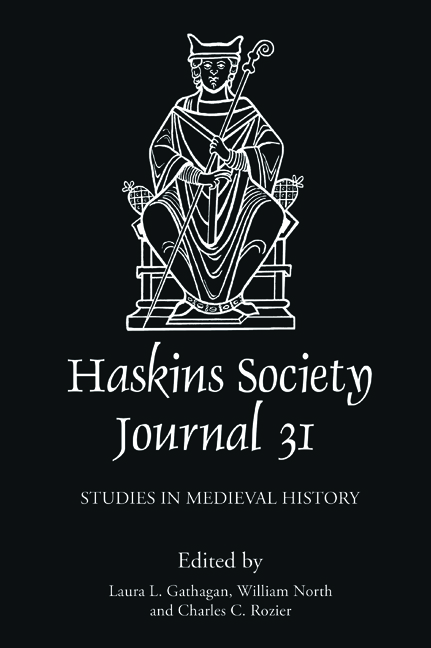Book contents
- Frontmatter
- Contents
- Figures and Tables
- Editors’ Note
- Abbreviations
- 1 Social Mobility and Manumissions in Early Medieval England
- 2 Flemish Settlements beyond Flanders: A Review and New Perspectives on Transregional Medieval Settlement Landscapes in Britain
- 3 The Road to Babylon: The First Crusade as Moral Performance
- 4 ‘Normans’ on the First Crusade: Actions and agendas of Two Crusaders: Robert Curthose and Bohemond of Taranto
- 5 The War Memoirs of Geoffroy of Villehardouin
- 6 Women in the Principality of Antioch: Power, Status, and Social Agency
- 7 The Story of the Veil: Matilda of Scotland, Controversy, and Imagination in Anglo-Norman Historiography
- 8 Political Identity and the Succession of Henry II
- 9 Competing Visions of the Past: Norman Identities in the Thirteenth-Century Chronique de Normandie
- 10 Rustics Petitioning to Parlement in the Thirteenth Century: A Case Study
5 - The War Memoirs of Geoffroy of Villehardouin
Published online by Cambridge University Press: 15 December 2020
- Frontmatter
- Contents
- Figures and Tables
- Editors’ Note
- Abbreviations
- 1 Social Mobility and Manumissions in Early Medieval England
- 2 Flemish Settlements beyond Flanders: A Review and New Perspectives on Transregional Medieval Settlement Landscapes in Britain
- 3 The Road to Babylon: The First Crusade as Moral Performance
- 4 ‘Normans’ on the First Crusade: Actions and agendas of Two Crusaders: Robert Curthose and Bohemond of Taranto
- 5 The War Memoirs of Geoffroy of Villehardouin
- 6 Women in the Principality of Antioch: Power, Status, and Social Agency
- 7 The Story of the Veil: Matilda of Scotland, Controversy, and Imagination in Anglo-Norman Historiography
- 8 Political Identity and the Succession of Henry II
- 9 Competing Visions of the Past: Norman Identities in the Thirteenth-Century Chronique de Normandie
- 10 Rustics Petitioning to Parlement in the Thirteenth Century: A Case Study
Summary
Geoffroy of Villehardouin begins his account of the Fourth Crusade in 1198 with Fulk of Neuilly, the charismatic preacher and miracle-worker who set the stage for Pope Innocent III's proclamation of crusade to recover Jerusalem. Villehardouin then recounts the cross-taking in November 1199 by counts Thibaut III of Champagne and Louis of Blois with their barons at Écry (modern Asfeld), in the valley of the Aisne south of Château-Porcien, before proceeding to the events leading up to the conquest of Constantinople in April 1204. Villehardouin's narrative is, of course, a foundational text for understanding the Fourth Crusade, but it also illuminates the life of the marshal of Champagne, much like the History of William Marshal portrays the life of the marshal of England, his exact contemporary.
The story of Villehardouin's memoirs begins not in 1198 but nine years later, in September 1207, when Villehardouin, marshal of Romania, returned to Constantinople after a summer campaigning against the Bulgarians. Conditions were dire. The Bulgarian King Kalojan was systematically devastating the countryside beyond the capital; virtually all the cities in Thrace had been destroyed and their residents killed, enslaved, or exiled. Only remnants of the great crusade army remained after its crushing defeat at the battle of Adrianople in April 1205 and the departure that same month of boatloads of knights bound for home. All the original crusade leaders had died: counts Thibaut of Champagne, Baldwin of Flanders, Louis of Blois, Hugh of Saint-Pol, the doge of Venice, and, most recently, Boniface of Montferrat (4 September 1207) and Bishop Nivelon of Soissons (13 September). In September 1207, three and a half years after the conquest, the former provinces of the Byzantine empire were a scene of devastation, and it looked as if the western occupation would not endure.
During the next nine months in Constantinople, between September 1207 and July 1208, the sixty-year-old marshal dictated his memoirs of the crusade and its aftermath before returning to the field in command of a company of knights. Although his account is cited variously as a récit, a memoir, a history, and a chronicle of the Fourth Crusade (the terms are often used interchangeably), I think it is most authentically described by the genre ‘memoirs’, and more specifically war memoirs that read almost as if they were the last testament of a soldier in a war zone whose fate seemed increasingly grim.
- Type
- Chapter
- Information
- The Haskins Society Journal 312019. Studies in Medieval History, pp. 81 - 94Publisher: Boydell & BrewerPrint publication year: 2020

